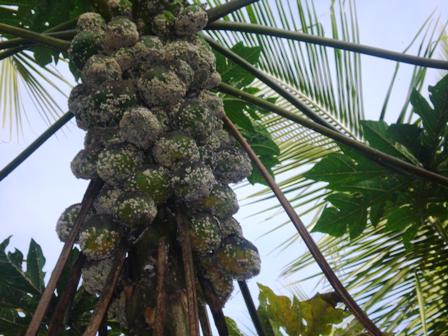New papaya pest yet to be named |06 May 2013

The National Plant Protection Office (NPPO) has been working closely with its partners in the region to try and confirm the species of the bug which was officially reported in January.
Randy Stravens, principal officer at the NPPO of the Seychelles Agricultural Agency (SAA) at Union Vale said since then they have responded to all requests and calls from growers for assistance and carried out site visits.
He said most of them who have called are backyard growers, with only two registered farmers.
He said since the first report of infestation, plant protection officers have been very active trying to deal with the situation and actually they are conducting a survey in direct consultation with farmers and backyard growers to determine the status of the pest.
“We have conducted over 30 visits and collected various samples of the pest for identification and confirmation of the species and determination of their host plants,” said Mr Stravens.
The pest, suspected to be probably another mealy bug species namely papaya mealy bug, have piercing- and sucking mouthparts and feed by inserting their mouthparts into plant tissue and sucking out sap. The papaya mealy bug infestation appears on leaves, stem and fruit as clusters of cotton-like masses.
The suspected mealy bug species injects a toxin as it feeds on leaves and fruit which results in chlorosis (yellowing), stunting, deformation, early leaf and fruit drop, and buildup of honeydew. The honey dew excreted by the bug and the associated black sooty mould formation impairs photosynthetic efficiency of the affected plants.
The bugs has been found in association with ants that tend to protect them and other species of mealy bugs such as two-tailed mealy bug (ferrisia vigata) when causing damage, something which makes identification more complex.
Mr Stravens said that the infestations of the papaya mealy bug has been mainly observed on papaya (pawpaw) and it is also widespread on ornamental plants like frangipani and hibiscus.
He said at present there may be several farmers and other individuals whose papaya or ornamental plants are being infested but they are either controlling the pest by their own means without help or they are just dismissing it as being the already existing mealy bug species namely Sacharicoccus sacchari (Sugarcane Mealy bug), Ferrisia virgata (Striped Mealy bug), Planococcus citri (Citrus Mealy Bug) and Pseudococcus longispinus (long tailed Mealy bug).
Control measures being encouraged include increased sanitation, use of bio-products like laststraw but the use of pesticides is being discouraged as the pest develops quick resistance to it.
The NPPO has sought assistance through regional cooperation from the CIRAD, Réunion, for identitifcation and confirmation of the pest species. CIRAD is a regional French research centre working with developing countries to tackle international agricultural and development which had requested a number of samples from different hosts and sites. This has already been done by the NPPO which is waiting for an official confirmation identifying the pest.
Mr Stravens said the office is meanwhile continuing with its work planned to monitor the pest population, determine their hosts, identify any possible natural enemies or parasitoid or predators, carry out on-farm or station research work activities for effective control, develop an effective and sustainable control programme to minimise the impact of the pest species and prepare informative materials.
‘‘We are in touch with different organisations we are affiliated with like Pestnet, which is providing us with information on such pests, to help us on the best control measures to adopt,” said Mr Stravens.
But he stressed that the NPPO’s priority is to focus on an integrated pest management (IPM) to effectively control the pest.
“We have also developed a questionnaire for farmers to get their input on the difficulties they face, problems with and the types of pests affecting them, control measures they are using and how affected they are,” Mr Stravens added.
With regard to how the pest could have entered the country Mr Stravens said this remains to be discovered but stressed that there are strict phytosanitary control measures in place at the two main entry points -- airport and ports.
But there are challenges. He said there are people still smuggling plants and plant products into the country. There are also some private yachts and other boats entering the country which are not necessarily going through required necessary procedures. There is also the possibility that the bug could have been carried by strong winds and with the recent tropical cyclones, the possibility could not be ruled out.
It is to be noted that Mauritius and Reunion islands are also suffering similar infestations which started around the same time as here.
Mr Stravens is once again calling on members of the public to follow the procedures and regulations in place for importing plants and plant products and seek more help and advice where and when required.
He is also calling on private boat/ship/aircraft, owners/managers and/or companies on outer islands to ensure people do not bring infested plants and fruits which can easily spread the pests.
He stressed that the authorities concerned are doing their best to prevent and minimise the threat of invasive alien species and plant pests and diseases from entering the country but for this to be effective, cooperation from everyone is crucial.
“Challenges and risks will always be there but we need to do whatever we can to minimise the impacts on our environment and agriculture development,” Mr Stravens stressed.
M-A.L.




